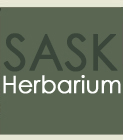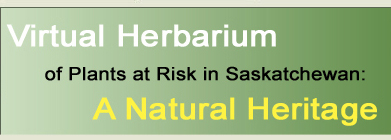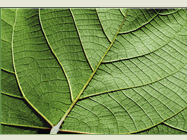|
| Antennaria corymbosa
E. Nels. |
|
| |
| TAXONOMY |
| |
| Family: |
Asteraceae or Compositae |
| Genus: |
Antennaria |
| |
| Species Synonyms: |
Antennaria acuta Rydb.
Antennaria
dioica var. corymbosa (E. Nels.) Jepson
Antennaria
hygrophila Greene
Antennaria nardina Greene |
| Common Names: |
flattop pussytoes
meadow everlasting |
| |
| DISTRIBUTION |
| |
| Canada: |
Alberta – southwestern Saskatchewan |
| Saskatchewan: |
southwestern Saskatchewan; Cypress Hills |
| Ecoregion: |
Cypress Upland |
| |
| HABITAT |
| |
| Saskatchewan: |
open woods and prairies in dry
to moist soil |
| Canada: |
dry fescue prairie |
| |
| RARITY STATUS |
| |
Provincial
Status According
to Harms (2003): |
Endangered |
| Nature Conservancy
Status: |
G5 N1 S1 |
Saskatchewan
Species at
Risk Status: |
None |
| COSEWIC Status:
|
None |
| |
| Meadow everlasting
is endangered because of extreme rarity. This plant is located in one subregion
of the province and is almost always locally sparse. No immediate threats
are known but are possible in the future. |
| |
| SPECIES
DESCRIPTION |
| |
| Height: |
10 – 30 cm tall |
| Roots: |
rhizome |
| Stems: |
runners leafy; stems solitary,
slender, loosely mat forming, with a light covering of short, mangled hairs |
| Leaves: |
basal and on the stem; basal
2 – 4 cm long, < 5 mm wide, narrowly inversely lance-shaped to
spatula shaped, apex with a sharp, abrupt point, base tapering, greyish,
hairy on both sides; stem leaves alternate, sessile, reduced upwards, linear,
apex with a sharp, abrupt point |
| Inflorescence: |
several heads in compact cluster;
stalk short; bracts 4 – 5 mm high, whitish with dark brown spots at
base, tip whitish (may be light pink when young) |
| Flowers: |
petals white |
| Fruits: |
achene not bumpy, pappus present |
| |
| ANAPHALIS
VS ANTENNARIA KEY FOR SPECIES FOUND IN SASKATCHEWAN |
| Only one species
of Anaphalis grows in Saskatchewan, but Anaphalis is very
similar in appearance to Antennaria. |
| |
|
| 1 May have runners; basal leaves conspicuous,
may be in a rosette, stem leaves few and reduced upwards, bracts white to
yellow-tinged to rose |
Antennaria |
| 1 Runners absent; basal leaves deciduous,
stem leaves many and not markedly reduced upwards, bracts pearly white |
Anaphalis |
| |
|
| ANTENNARIA
KEY FOR SPECIES FOUND IN SASKATCHEWAN |
|
| |
|
| 1 Heads solitary |
A. dimorpha |
| 1 Heads more than one |
2 |
| |
|
| 2 Runners absent, not mat forming;
basal leaves erect, commonly >8 x as long as broad, acute to short-tapered
at tip, not rosette forming |
3 |
| 2 Usually with numerous leafy runners
(though may be absent in some species if densely tufted), mat forming; basal
leaves spreading and forming rosettes |
4 |
| |
|
| 3 Bracts in 3 – 4 unequal series,
white or whitish, tapered to obtuse |
A. anaphaloides |
| 3 Bracts in 6 – 7 series, deep
brown to black, at least inner ones gradually tapered to the tip |
A. pulcherrima |
| |
|
| 4 Rosette leaves to over 5 mm wide;
heads 2 or more; achenes bumpy, at least when young |
5 |
| 4 Rosette leaves < 5 mm broad;
heads several; achenes not bumpy |
6 |
| |
|
| 5 Upper leaf surface distinctly less
hairy than lower, becoming hairless with age |
A. neglecta* |
| 5 Upper leaf surface nearly as densely
hairy as lower, hairless only in extreme age |
A. parvifolia** |
| |
|
| 6 Bracts with dark spot at the base |
A. corymbosa |
| 6 Bracts without dark spot at base |
7 |
| |
|
| 7 Bracts pink to rose |
A. rosea |
| 7 Bracts white, brown, yellow-brown
or green at base |
8 |
| |
|
| 8 Young flowering heads not nodding,
bracts brown, yellow-brown or green at base, dry and membranous parts brown
or whitish |
A. umbrinella |
| 8 Younger flowering heads nodding,
inner bracts white-brown |
A. microphylla |
| |
|
| *there are three
varieties in Saskatchewan, not addressed in this key |
|
| ** once considered
A. aprica if: bracts 8 – 13 mm high; stem leaves 5 –
7, and A. parvifolia if: bracts 4 – 7 mm high; stem leaves
8 – 12 |
|






